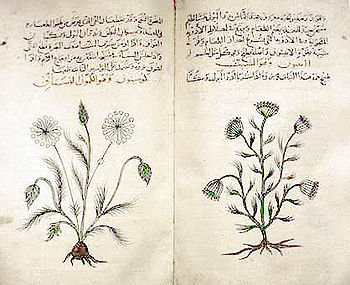Middle Ages

While there are certainly texts from the medieval period that denote the uses of herbs, there has been a long-standing debate between scholars as to the actual motivations and understandings that underline the creation of herbal documents during the medieval period. The first point of view dictates that the information presented in these medieval texts were merely copied from their classical equivalents without much thought or understanding. The second viewpoint, which is gaining traction among modern scholars, states that herbals were copied for actual use and backed by genuine understanding.
Some evidence for the suggestion that herbals were utilized with knowledgeable intent, was the addition of several chapters of plants, lists of symptoms, habitat information, and plant synonyms added to texts such as the Herbarium. Notable texts utilized in this time period include Bald's Leechbook, the Lacnunga, the peri didaxeon, Herbarium Apulei, Da Taxone, and Madicina de Quadrupedidus, while the most popular during this time period were the Ex Herbis Femininis, the Herbarius, and works by Dioscorides.
Benedictine monasteries were the primary source of medical knowledge in Europe and England during the Early Middle Ages. However, most of these monastic scholars' efforts were focused on translating and copying ancient Greco-Roman and Arabic works, rather than creating substantial new information and practices. Many Greek and Roman writings on medicine, as on other subjects, were preserved by hand copying of manuscripts in monasteries. The monasteries thus tended to become local centers of medical knowledge, and their herb gardens provided the raw materials for simple treatment of common disorders. At the same time, folk medicine in the home and village continued uninterrupted, supporting numerous wandering and settled herbalists. Among these were the "wise-women" and "wise men", who prescribed herbal remedies often along with spells, enchantments, divination and advice. One of the most famous women in the herbal tradition was Hildegard of Bingen. A 12th-century Benedictine nun, she wrote a medical text called Causae et Curae. During this time, herbalism was mainly practiced by women, particularly among Germanic tribes.
There were three major sources of information on healing at the time including the Arabian School, Anglo-Saxon leechcraft, and Salerno. A great scholar of the Arabian School was Avicenna, who wrote The Canon of Medicine which became the standard medical reference work of the Arab world. "The Canon of Medicine is known for its introduction of systematic experimentation and the study of physiology, the discovery of contagious diseases and sexually transmitted diseases, the introduction of quarantine to limit the spread of infectious diseases, the introduction of experimental medicine, clinical trials, and the idea of a syndrome in the diagnosis of specific diseases. ...The Canon includes a description of some 760 medicinal plants and the medicine that could be derived from them." With Leechcraft, though bringing to mind part of their treatments, leech was the English term for medical practitioner. Salerno was a famous school in Italy centered around health and medicine. A student of the school was Constantine the African, credited with bringing Arab medicine to Europe.
Comments
Post a Comment